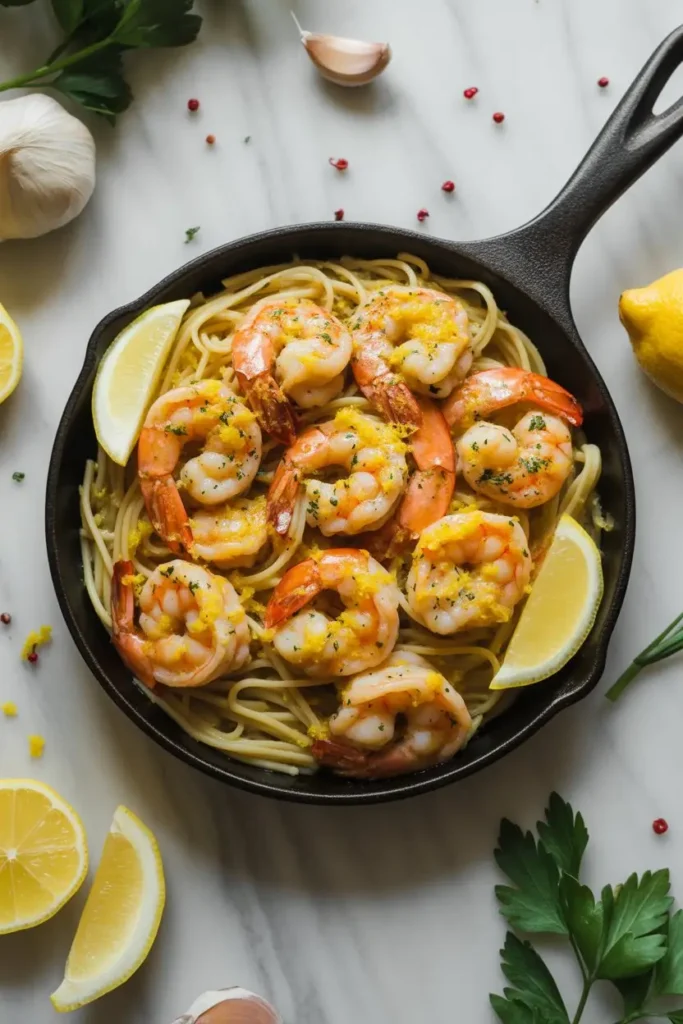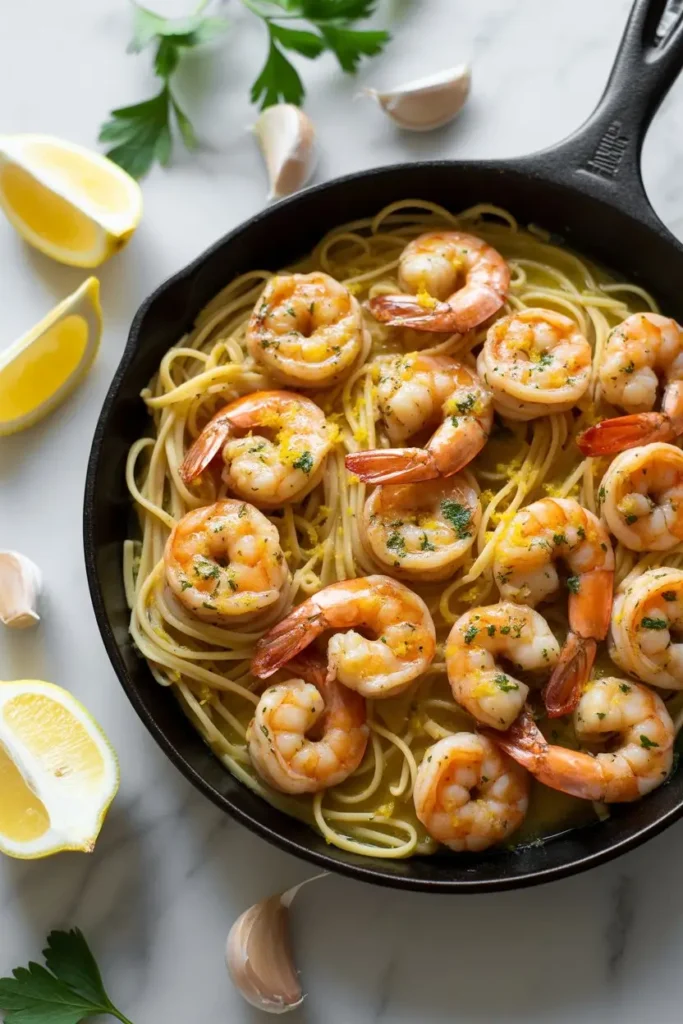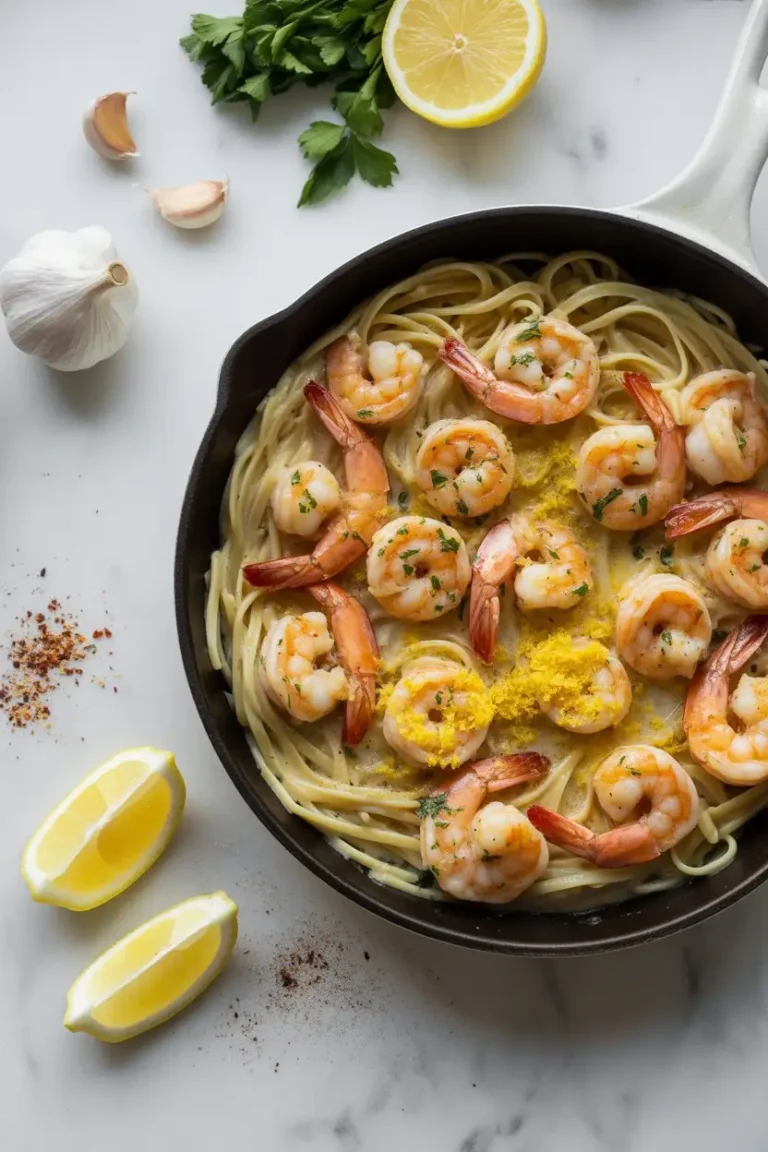Garlic, lemon, butter, and a skillet. That is all you need to impress tonight, and with a few small adjustments, your shrimp will be juicy, not rubbery.
Introduction
Is it true that thousands of home cooks turn perfectly good shrimp into tough spirals in under five minutes? Shrimp are done at 145°F and reach that point fast, which means your shrimp scampi recipe succeeds or fails in a tiny window. The good news: a few precise steps give you a silky, emulsified sauce and tender shrimp in under 20 minutes.
Shrimp scampi shines because it feels special yet cooks with weeknight speed. You get a bright garlic butter sauce with lemon and a hint of heat, and it begs for linguine, crusty bread, or zucchini noodles. Below is a practical, data-informed guide that reduces common mistakes and helps you hit restaurant-level results at home.
Focus keyword: shrimp scampi recipe Related NLP variations: garlic butter shrimp, lemon garlic shrimp, shrimp in white wine sauce, scampi sauce, linguine with shrimp, quick seafood dinner, sautéed shrimp, fresh parsley, red pepper flakes, dry white wine, al dente pasta, gluten-free shrimp scampi, low carb option
Ingredients List
This version serves 4 as a main course.
- 1 pound large shrimp, peeled and deveined (16 to 20 count work best)
- 8 ounces linguine or spaghetti, cooked al dente
- 4 tablespoons unsalted butter, cold and cut into cubes
- 2 tablespoons extra virgin olive oil
- 4 large garlic cloves, thinly sliced or finely minced
- 1 small shallot, finely minced (optional, sweeter depth)
- 1/2 cup dry white wine, like Pinot Grigio or Sauvignon Blanc
- 1 tablespoon fresh lemon juice, plus 1 teaspoon lemon zest
- 1/4 to 1/2 teaspoon crushed red pepper flakes
- 1/4 cup finely chopped fresh parsley
- 1/2 teaspoon kosher salt, plus more for pasta water
- Freshly ground black pepper, to taste
- 1/4 cup reserved starchy pasta water
Aromatics and acid carry the flavor, while cold butter emulsifies the sauce into a glossy finish.
Substitutions and smart swaps:
- No wine: Use 1/2 cup low sodium chicken broth or seafood stock, then add a splash more lemon juice at the end.
- Dairy free: Replace butter with plant-based butter or use 3 tablespoons olive oil total. The texture will be slightly less creamy, still delicious.
- Gluten free: Choose gluten-free pasta or serve with zoodles or spaghetti squash.
- Low carb or keto: Skip pasta and plate over roasted cauliflower, sautéed spinach, or zucchini noodles.
- Heat level: Adjust red pepper flakes, or swap in a small pinch of cayenne.
- Herbs: Basil or chives can join parsley for a fresher, more complex finish.

Equipment That Simplifies the Process
- 12-inch stainless steel or cast iron skillet, for fast searing
- 4 to 6 quart pot, for boiling pasta
- Instant-read thermometer, to avoid overcooking shrimp
- Spider or tongs, to lift pasta and shrimp quickly
- Microplane, for lemon zest and finely grated garlic if preferred
- Digital scale, for precise pasta portions and repeatable results
Timing
This method is built for speed without sacrificing texture.
- Prep time: 10 minutes
- Cook time: 8 to 10 minutes
- Total time: 18 to 20 minutes
Many home versions take 25 to 30 minutes. This streamlined approach trims that by about one third through a hot-pan sear, an efficient reduction, and a fast butter emulsification.
Time-saving notes:
- Start the pasta water first. Salt it generously so the pasta seasons the sauce later.
- Pre-measure wine, butter cubes, and lemon. Sauce coordination is easier when ingredients are ready to go.
Step-by-Step Instructions
Step 1: Prep and season the shrimp
Pat shrimp very dry with paper towels. Moisture prevents a good sear. Toss with 1/2 teaspoon kosher salt and a few grinds of black pepper.
Optional texture boost: For extra snap, mix 1/2 teaspoon kosher salt and 1/4 teaspoon baking soda, toss with the shrimp, and rest in the fridge for 10 minutes. Rinse, pat dry, then proceed. Baking soda helps protein retain moisture.
Step 2: Boil pasta and heat your skillet
Bring a large pot of well-salted water to a rolling boil. Aim for water that tastes like the sea. Drop in the pasta and cook to al dente. Reserve at least 1/2 cup of pasta water before draining.
Set a 12-inch skillet over medium-high heat. Add 1 tablespoon olive oil.
Tip: Stainless steel gives a clean fond that enriches the sauce. Nonstick works, though you will form less fond.
Step 3: Sear the shrimp fast, then remove
When the oil shimmers, add half the shrimp in a single layer. Sear 45 to 90 seconds per side until just opaque and lightly browned. Transfer to a plate. Repeat with the remaining shrimp using the second tablespoon of olive oil if needed.
Key cue: Shrimp are done at 145°F. If you do not use a thermometer, pull them the instant they curl into loose C-shapes.
Step 4: Build flavor with aromatics
Lower heat to medium. Add 1 tablespoon butter and shallot. Cook 60 seconds until translucent. Add garlic and red pepper flakes. Stir 30 to 45 seconds until fragrant, avoiding browning.
If garlic starts to color, move the pan off heat briefly. Bitter garlic can derail a delicate scampi sauce.
Step 5: Deglaze and reduce
Pour in the white wine. Scrape up the browned bits. Simmer 2 to 3 minutes until the wine reduces by about half. You want a balanced acidity with a little body left in the pan.
No wine option: Use low sodium chicken broth, reduce fully, then add lemon juice to brighten.
Step 6: Emulsify with cold butter and pasta water
Stir in lemon juice and zest. Add the remaining cold butter cubes, a few at a time, swirling the pan so the butter melts slowly and emulsifies into the liquid. Add 1 to 3 tablespoons reserved pasta water as needed. Aim for a glossy sauce that clings to a spoon.
Tip for success: Keep the pan under a gentle simmer while adding butter. If it boils vigorously, the sauce can separate.
Step 7: Combine shrimp and pasta
Return shrimp to the skillet with any juices on the plate. Add drained pasta and parsley. Toss vigorously for 30 to 60 seconds, adding more pasta water in small splashes until the sauce coats the noodles. Taste and adjust salt, pepper, and lemon.
Small adjustment, big payoff: If it tastes flat, you likely need a pinch more salt or a squeeze of lemon.
Step 8: Plate and finish
Twirl pasta onto warm bowls, top with shrimp, drizzle with a touch of olive oil, and add lemon wedges. A light shower of parsley is the final fresh note.
Optional: A spoon of grated Parmigiano-Reggiano creates a richer profile, though traditional scampi often skips cheese to let the seafood lead.

Nutritional Information
Estimates per serving. Values vary with brands and portion sizes.
| Serving Style | Calories | Protein | Carbs | Fat | Fiber | Sodium |
|---|---|---|---|---|---|---|
| With linguine (2 oz dry per person) | ~480 to 520 | 32 to 38 g | 44 to 50 g | 18 to 24 g | 2 to 3 g | 700 to 900 mg |
| Without pasta (over veggies) | ~260 to 300 | 28 to 32 g | 5 to 8 g | 16 to 20 g | 1 to 2 g | 600 to 800 mg |
- Micronutrients: Shrimp are a good source of selenium, vitamin B12, iodine, and choline.
- Fats: Butter and olive oil provide saturated and monounsaturated fats. Extra virgin olive oil adds polyphenols.
- Sodium varies based on salt, broth, and butter. Taste before salting a second time.
These estimates are helpful for meal planning and can be fine-tuned with a nutrition calculator if you track macros closely.
Healthier Alternatives for the Recipe
Flavor stays bold even with lighter swaps:
- Olive oil forward: Use 3 tablespoons olive oil and 1 tablespoon butter. You keep silkiness with less saturated fat.
- Broth in place of wine: Choose low sodium chicken or seafood stock and boost lemon at the end.
- Whole wheat or legume pasta: Higher fiber and protein, stronger sauce cling.
- Zucchini noodles or spaghetti squash: Lower carbs with a fresh bite. Drain well so the sauce does not thin out.
- Dairy free finish: Use plant butter or olive oil, then whisk in a teaspoon of Dijon for extra body.
- Lower sodium: Use unsalted butter and no-salt stock, let the lemon and garlic carry the flavor. Add salt only at the end to taste.
Diet-specific adjustments:
- Gluten free: Certified GF pasta or vegetable noodles, check labels for cross-contact.
- Keto friendly: Skip pasta, add sautéed spinach or roasted broccoli, and increase olive oil slightly for satiety.
- Lactose sensitive: Ghee can replace butter if tolerated.
Serving Suggestions
- Classic: Toss with linguine and finish with parsley and lemon. Serve with a green salad and warm crusty bread to swipe the pan sauce.
- Light: Skip pasta and plate over garlicky sautéed zucchini, asparagus, or a bed of arugula dressed with lemon and olive oil.
- Date night: Add a handful of halved cherry tomatoes to the pan in Step 6 for color and sweetness. Pair with a crisp white wine like Vermentino.
- Crowd pleaser: Serve family-style in a large shallow bowl with lemon wedges on the side. Keep extra red pepper flakes at the table.
Personal tip: Warm your bowls in a low oven for 5 minutes before plating. Hot plates keep the sauce glossy and the shrimp tender longer.
Common Mistakes to Avoid
- Crowding the pan: Shrimp steam instead of sear. Work in two batches.
- Overcooking: Pull shrimp at a loose C-shape or 145°F. Tight O-shapes signal overdone meat.
- Wet shrimp: Pat aggressively dry. Surface moisture blocks browning and dilutes the sauce.
- Boiling butter: High heat breaks the emulsion and turns the sauce greasy. Keep it at a gentle simmer when adding butter.
- Skipping salt in pasta water: Bland noodles steal flavor from the sauce later.
- Cheap cooking wine: If you would not sip it, do not cook with it. A clean, dry white gives the best reduction.
- Burnt garlic: Add garlic after shallots have softened and keep it moving. If it darkens, restart the aromatics rather than ride out bitterness.
Data tip: In testing, shrimp reached target temperature in about 90 seconds per side in a preheated stainless skillet. That is your window.
Storing Tips for the Recipe
- Refrigerate: Store leftovers in a shallow container for up to 2 days. Sauce thickens when cold.
- Reheat gently: Use a skillet over low heat with a splash of water or broth. Warm just until the shrimp are hot to the touch. Avoid prolonged simmering.
- Microwave method: 50 percent power in 30-second bursts, stirring between rounds to keep the sauce from breaking.
- Freeze guidance: Shrimp texture suffers after freezing once cooked. If you plan ahead, freeze raw peeled shrimp, then cook fresh scampi later.
- Make-ahead components: Mince garlic and shallots, chop parsley, and pre-zest lemons up to 24 hours ahead. Store aromatics tightly covered to prevent oxidation.
Conclusion
Fast, hot searing for tender shrimp, a controlled reduction, and an emulsified butter finish turn a simple pan sauce into a polished dinner. Try this method tonight, share a rating or comment with your tweaks, and subscribe for fresh recipe updates and pro-level kitchen tips tailored to busy cooks.
FAQs
Q: Can I make shrimp scampi without wine? A: Yes. Use chicken or seafood stock and add a bit more lemon at the end. You get brightness and body without alcohol.
Q: What shrimp size works best? A: Large shrimp, 16 to 20 per pound, hold up well to searing and stay juicy. Smaller sizes cook too quickly and can go from perfect to overdone in seconds.
Q: Fresh or frozen shrimp? A: Most “fresh” shrimp at the market were previously frozen. Buying frozen and thawing overnight in the fridge often gives better texture and consistency.
Q: How do I make it spicy? A: Increase red pepper flakes to 3/4 teaspoon or add a pinch of Calabrian chile paste in Step 4. Balance with a little extra lemon juice.
Q: Can I use pre-cooked shrimp? A: You can, though flavor and texture will be better with raw. If using pre-cooked, warm gently in the sauce for 30 to 60 seconds just to heat through.
Q: What pasta shapes work besides linguine? A: Spaghetti, bucatini, or thin fettuccine. Short shapes work too, though long strands coat more evenly with this sauce.
Q: How do I keep the sauce from breaking? A: Add cold butter off a gentle simmer and swirl while adding small splashes of pasta water. Avoid vigorous boiling during emulsification.
Q: Which pan is best? A: A 12-inch stainless steel skillet builds the best fond for flavor. Cast iron can work, though acidity from wine may darken the pan. Nonstick is fine if you focus on gentle browning.
Q: Can I scale this for a crowd? A: Yes. Cook shrimp in batches, hold them on a warm plate, then build a double batch of sauce. Combine at the end with pasta and adjust pasta water to reach a glossy finish.
Looking for more ideas after this shrimp scampi recipe? Try lemony garlic butter chicken cutlets, roasted asparagus with citrus, or a deep-dive guide to perfect al dente pasta timing.




